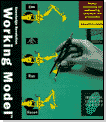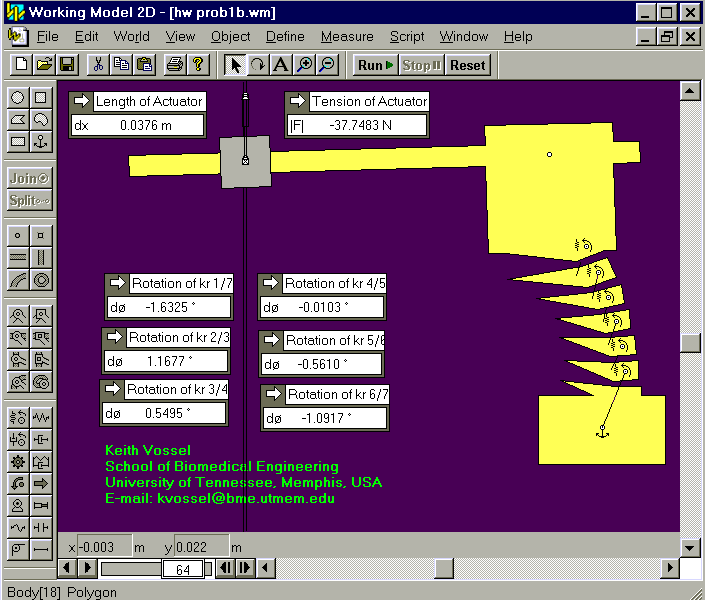Raccolta casi Working Model, visualNastran & SimWise - BME

Contatto Editoriale:
Paolo Lista,
Lista Studio srl®
Borgo Belvigo 33, 36016 Thiene Vi ITALY
tel/fax 0445,372479 o info@lista.it
Biomedical engineers use simulation software to study the human body at the University of Tenessee, Memphis, Usa
While mechanical engineering software is commonly used for designing,
analyzing and testing car and airplane parts or other complex mechanical
systems, its ability to simulate dynamic conditions also lends itself
to studying the movement and mechanics of the human body.
At the School of Biomedical Engineering
(BME) at the University of Tennessee,
Memphis, graduate students in a biomechanics course develop mechanically
equivalent models of bone-joint systems using Working Model(r) software
and apply engineering principles to study the body's musculoskeletal
systems.
Biomechanical engineers conduct research to characterize the motion of human joints for different health conditions, including normal, pathological, injured, or surgically altered. An understanding of a joint's movement can be used to diagnose its health or monitor the progress of different rehabilitative techniques used to restore joint mobility and function. Their research may even lead to improvements in surgical techniques or design of joint implants.
"Engineering theory of mechanisms and linkage systems can serve as a basis for studying human joint movement and mechanics," says Denis DiAngelo, Ph.D., a mechanical engineer and assistant professor in the School of Biomedical Engineering. "While it is common to use graphical methods or analytical techniques to analyze linkage systems, Working Model enables students to study the continuous range of motion of bone-joint systems, whether the knee, finger, hip, or spine."
Working Model uses many engineering principles familiar to the BME students, such as kinematics, dynamics and numerical methods, and serves as a tool for students to apply this knowledge to study medical-related problems. The muscle-joint systems are modeled as a network of rigid bodies with curvilinear contacting surfaces or pinned joints connected by various mechanical components, including springs, dampers, and pulleys, which simulate the muscles or ligaments. Properties of the mechanical components can be defined with mathematical expressions to simulate the non-linear structural properties of tissue elements, while motors, actuators, sliders, or cable systems regulate the motion or load applied to the joint system.
The graduate BME program is located on the university's medical campus, and is one of only a few programs in the U.S. offering graduate BME degrees, a broad area of education combining mathematics, engineering and physics to study medical-related problems. Some graduate students in the BME program specialize in imaging, cell and tissue engineering, or blood flow mechanics. Others study joint implant mechanics or design prosthetic limbs.
Motion Study Solutions
According to DiAngelo, biomechanists often analyze human movement
with camera-based motion analysis hardware equipped with custom software
programs. The bone segments and joints are represented as
rigid links connected by simple pinned joints that are displayed as
stick figure images.
Unfortunately, modeling the human joint as a simple pinned connection
does not characterize its true, natural motion.
For students, being able to visualize realistic movement of a joint
is critical to understanding the interaction between the joint anatomy
and the surrounding muscles and ligaments.
Other simulation techniques
use mathematical expressions to define the contact surfaces and muscle
and ligament mechanics. Many of these programs require extensive
development, and do not provide animation features standard in Working Model.

In this picture there is a copy of a Working Model simulation of the cervical
spine loaded in extension. This model demonstrated that when the moment
arm is attached to the actuator with a pin joint rather that a pin joint
with a linear bearing, the motion in the sagittal plane is constrained
and the moment response of the cervical spine becomes excessive after
only a few degrees of global rotation. Note that the cervical spine is
inverted so that T1 is in the upper pot and C2 is in the lower pot.
Courtesy of Keith Vossel, BME, E-mail kvossel@bme.utmem.edu
While several solid modeling programs, such as Pro/ENGINEER or Adams, could be used to study joint movement, many academic budgets cannot support expensive, workstation-based software.
In 1994, DiAngelo considered the alternatives and installed Working Model software from Working Model, Inc. Today, biomedical engineering students work on a network of Pentium-based PCs running Working Model 2D and 3D software.
"We're really excited about the discoveries we're making with Working Model," DiAngelo says. "At the same time, we'd like to inform biomedical engineers of the many practical ways Working Model can advance their work once they see how we've incorporated the software into our teaching and research activities."
While DiAngelo praises Working Model, he also stresses the importance of understanding how the program manipulates the user-defined parameters to achieve a solution. The message DiAngelo gives his students is "check yourself."
"I ask students to solve problems with known solutions. This step enables them to understand how the software works," DiAngelo continues.
Modeling Joint Movement
DiAngelo's class has studied spine mechanics using Working Model.
The class looked at the upper neck region-the cervical spine-which
encounters a great deal of movement during normal daily activities.
According to DiAngelo, the complexity of the cervical spine continues
to challenge biomechanical engineers.
First, DiAngelo and his students imported digitized X-rays of a spine
into AutoCAD(r) design software from Autodesk, Inc. Next, anthropomorphic
and morphometric data from the adult population were used to generate a
parametric model of the spine. Using AutoMotion(tm), students exported
the CAD files directly into Working Model for simulation.
To study the mechanics of the spine, load and motion data from experimental
studies performed in the research lab were imported into the model.
To properly model the experimental set-up, additional mechanical components
were added to the spine model that represented the testing apparatus
and mounting fixtures.
Thomas Jansen, a BME graduate student, recently won multiple student competition awards at a biomedical engineering conference based on research using the cervical spine model. The simulation study looked at the influence of joint placement on spine kinematics. According to DiAngelo, it is often difficult to replicate the natural physiologic motion of human joints using mechanical testing machines. But, using the simulation model, Jansen studied different configurations to determine an optimal testing arrangement that more closely simulated the natural motion of the spine. Simulation studies like this help standardize biomechanical testing protocols for joint implants.
Real World Applications
DiAngelo envisions many real-world Working Model applications for biomedical engineers to work with surgeons, physical therapists, and others who work in biomechanics and rehabilitative medicine. For instance, simulation teaches therapists and biomedical engineers how the different ligaments affect the motion and stability of the joint. According to DiAngelo, Working Model would enable physical therapists treating knee injury patients to recognize the diagnosis and set appropriate treatment plans. Similarly, a better understanding of the knee's anterior cruciate ligament may enable biomedical engineers to improve ligament replacement designs.
Future Directions
After graduation, many of the BME students find employment with implant or device manufacturing companies, while others go on to work at university centers or health-related government agencies. What all of these students share is a unique approach to understanding the human body's movement and mechanics.
Eventually, biomedical engineers believe that by understanding the way joints move, they'll be able to design artificial joints and medical devices that function well with the human body. They'll also understand how the ligaments and muscles contribute to the movement and mechanics of the joints. While researchers continue to solve medical problems, biomedical engineers at the University of Tennessee, Memphis believe their work with Working Model will help validate and refine those solutions. In the end, this will save valuable research time and have a significant impact on patient welfare and health care costs.
